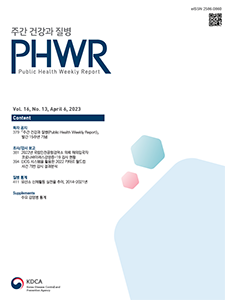Current Issue
Vol.16 No.13, April 06, 2023
-
Notice to Readers 2023-04-06
 0
0
 626
626
 207
207
Celebrating 15 Years of Public Health Weekly Report
Public Health Weekly Report 2023; 16(13): 379-380 https://doi.org/10.56786/PHWR.2023.16.13.1_K -
Surveillance Reports 2023-04-06
 0
0
 994
994
 292
292
A Brief Report of COVID-19 Test Results of Overseas Entrants to Korea as Requested by National Incheon Airport Quarantine Station in 2022
Sang Oun Jung, Karam Kang, Hanseul Jang, Sangmi Park, Young Jee Kim, Jihye Han, Sahyun Hong, Kyu-Sik Chang, Eun-Jung Lee, Jeong-Gu Nam*
Public Health Weekly Report 2023; 16(13): 381-393 https://doi.org/10.56786/PHWR.2023.16.13.2 Abstract
AbstractWe analyzed the COVID-19 test results of overseas entrants through Incheon International Airport in 2022. The total number of tests was 21,234, of which 6,149 were confirmed positive, and the positive rate was 29.0%, a significant increase from 5.3% in 2021. The increased test number, due to the prevalence of Omicron, was lasted until March 2022 and gradually decreased until June. The positive rate was also decreased to 5.6% in June. After that, the test number and positive rate began to increase again, and the positive rate was maintained from 34.9% to 59.3% until December. The COVID-19 tests were conducted on overseas entrants from 128 countries. The order of the top 15 countries was Unites States, Vietnam, Japan, etc. The number of tests in the top 15 countries was 16,498, which was 77.7% of the total number of tests. In the first half of the year, there were many tests conducted in the United States, Japan, Canada, etc., and in the second half, increased number of tests was confirmed in Philippines, Thailand, Vietnam, etc. The positive rates for each country showed a similar trend to the overall positive rate changes in most country including the 15 countries. This trend is presumed to be the result of mitigation of quarantine measures by stabilizing of the outbreak of COVID-19 due to Omicron and vaccination. As such, we will maintain a rapid and accurate laboratory inspection system to prevent and control infectious diseases derived from abroad such as COVID-19 at quarantine stage.
-
Surveillance Reports 2023-04-06
 0
0
 675
675
 177
177
Analysis of Event-Based Surveillance for 2022 FIFA World Cup in Qatar Using EIOS System
Chungman Chae, Jiyoung Oh, Yongmoon Kim, Seonyoung Lee, Geehyuk Kim, Sujin Hong, Soohyun Kim, Jia Lee, Sangwoo Tak
Public Health Weekly Report 2023; 16(13): 394-410 https://doi.org/10.56786/PHWR.2023.16.13.3 Abstract
AbstractInternational mass gatherings pose a significant risk for the rapid spread of infectious diseases due to large-scale population movements occurring in a short period and limited access to information on potential outbreaks. The Division of Risk Assessment of the Korea Disease Control and Prevention Agency employs the Epidemic Intelligence from Open Sources (EIOS) system to detect public health threat signals that could impact Koreans in six countries, including Qatar and neighboring countries, during the 2022 International Federation of Association Football World Cup, or enter Republic of Korea (ROK) through visitors. During the surveillance period, the EIOS system collected 18,431 articles related to monitoring the World Cup. Out of the 11 articles classified as public health threats, only one (0.01%) was determined to potentially impact the ROK or Koreans in the countries subjected to surveillance. The EIOS system allows for real-time monitoring of mass gatherings and is particularly useful for international gatherings, especially those hindered by a language barrier. When operating an event-based surveillance system, it is important to consider various factors such as the possibility and impact of a public health threat event, the size of the mass gatherings to be monitored, the level of media attention, available resources, and the sensitivity of the surveillance system. Continuously accumulating experience in operating the EIOS system for international mass gatherings and sharing knowledge with other countries, researchers, and international organizations that use the system are essential steps to enhance its efficiency and effectiveness.
-
QuickStats 2023-04-06
 1
1
 1770
1770
 323
323
Trends in the Prevalence of Aerobic Physical Activity, During 2014–2021
Public Health Weekly Report 2023; 16(13): 411-412 https://doi.org/10.56786/PHWR.2023.16.13.4

pp. 1433~1461
Most Keyword
?
What is Most Keyword?
- It is the most frequently used keyword in articles in this journal for the past two years.
Most Read
-
Waterborne and Foodborne Disease Outbreaks in the Republic of Korea, 2023
Myung-Jae Hwang, So Yeon Park, Hyungjun Kim, Se Jeong Yang, Sungchan Yang, Jin Seon Yang
Public Health Weekly Report 2025;18: 17-32 https://doi.org/10.56786/PHWR.2025.18.1.2 -
Implementation Plan for the Coronavirus Disease 2019 Vaccination for the 2024–2025 Season: Recommendations of the 6th Expert Committee on Immunization Practices
Hyewook Hwang, Wookeon Lee, Seohyeon Ahn, Young-Sook Choi, Seunghyun Lewis Kwon, Dongwoo Lee, Eun Hwa Choi, SokGoo Lee
Public Health Weekly Report 2025;18: 90-102 https://doi.org/10.56786/PHWR.2025.18.2.3
Editorial Office
+82-43-719-7569





 Full Text
Full Text Cite
Cite


